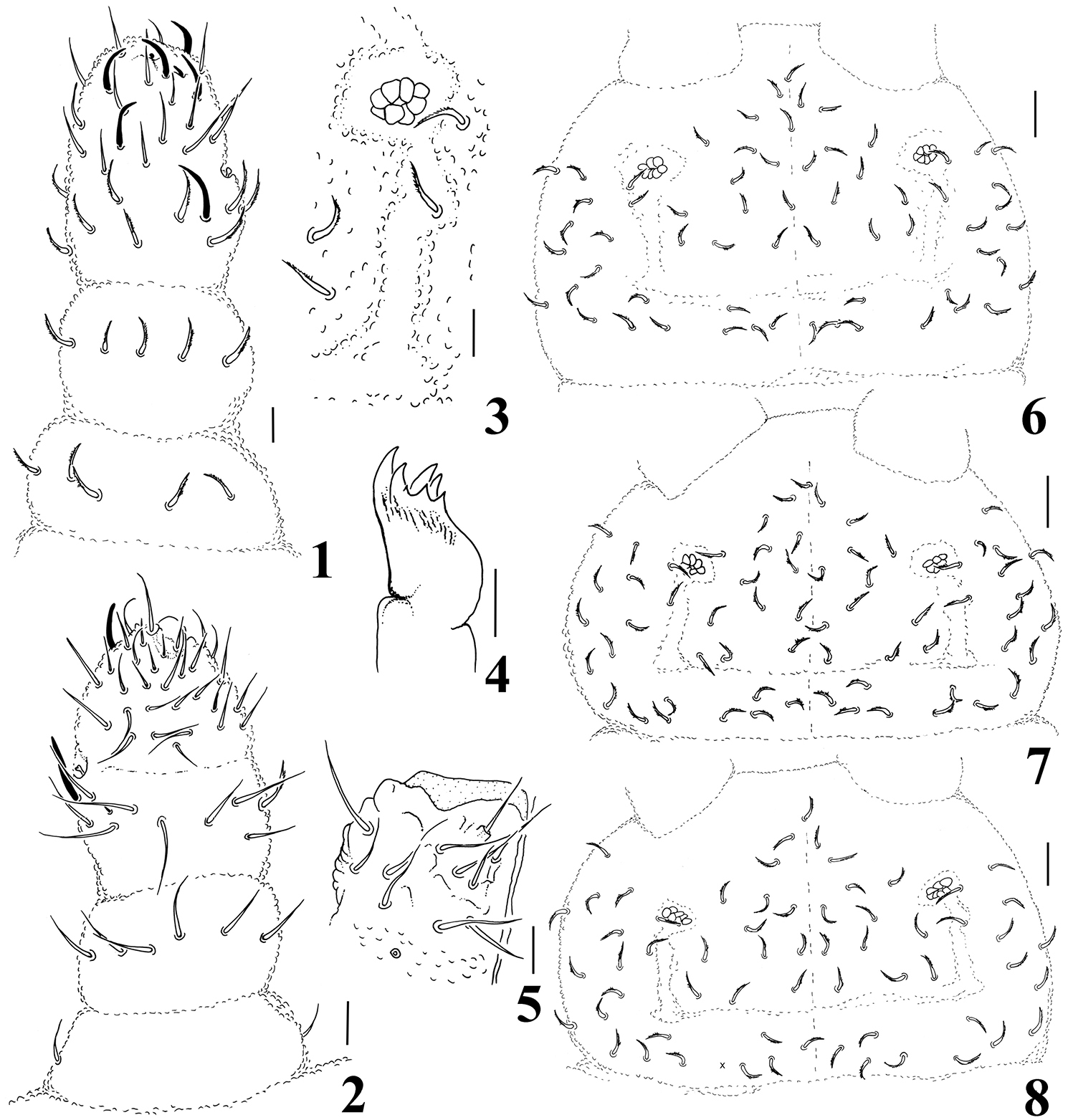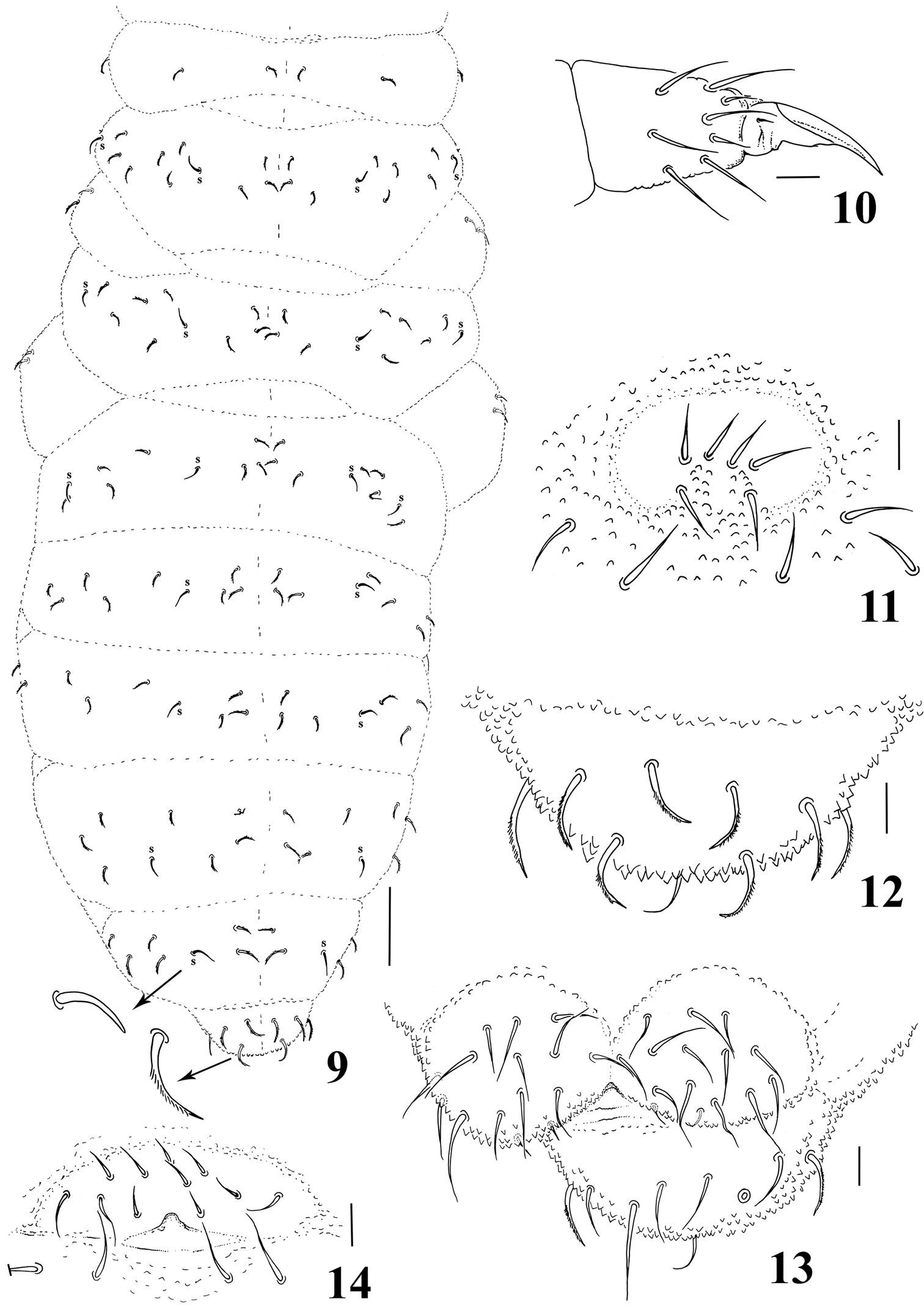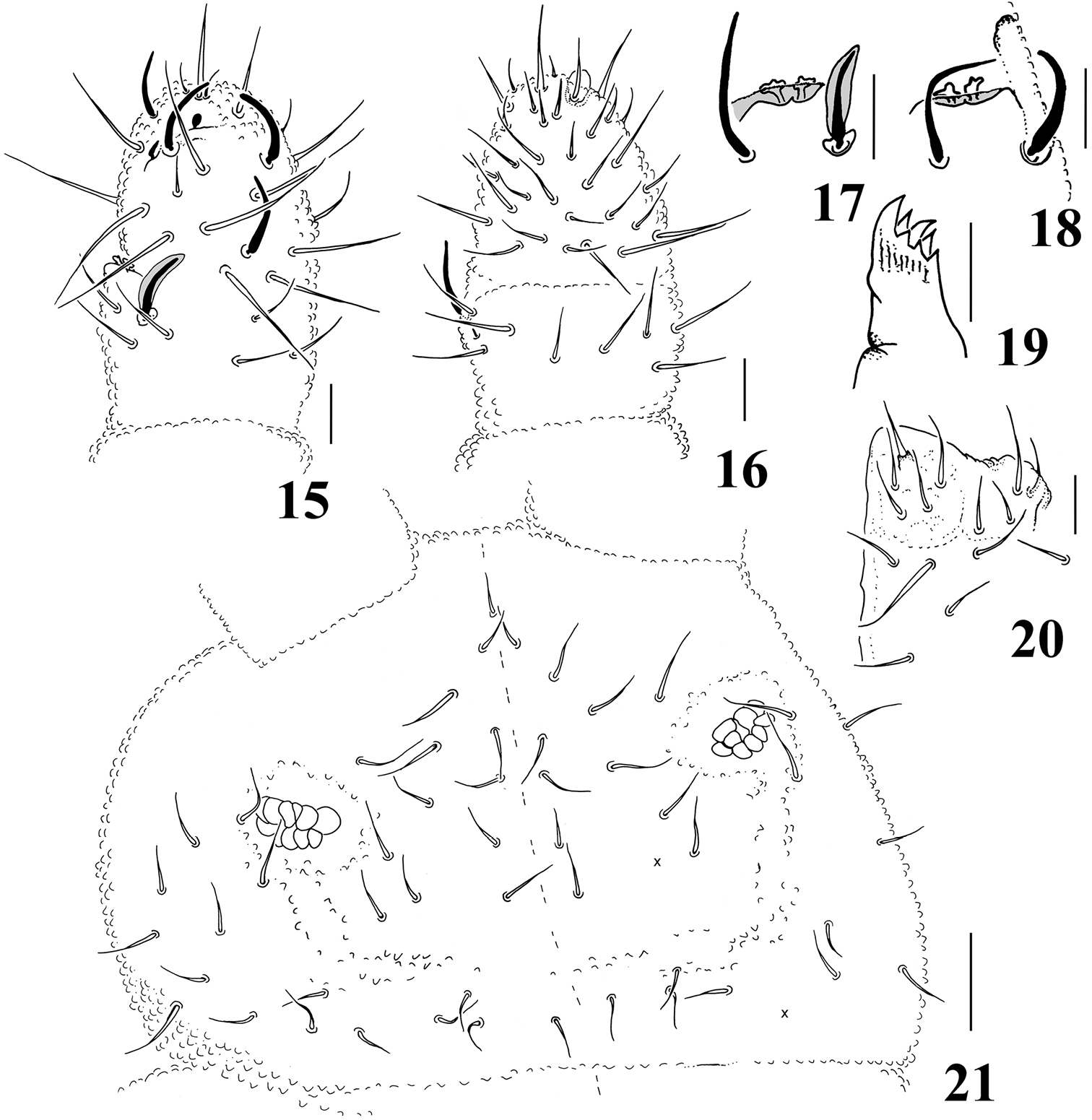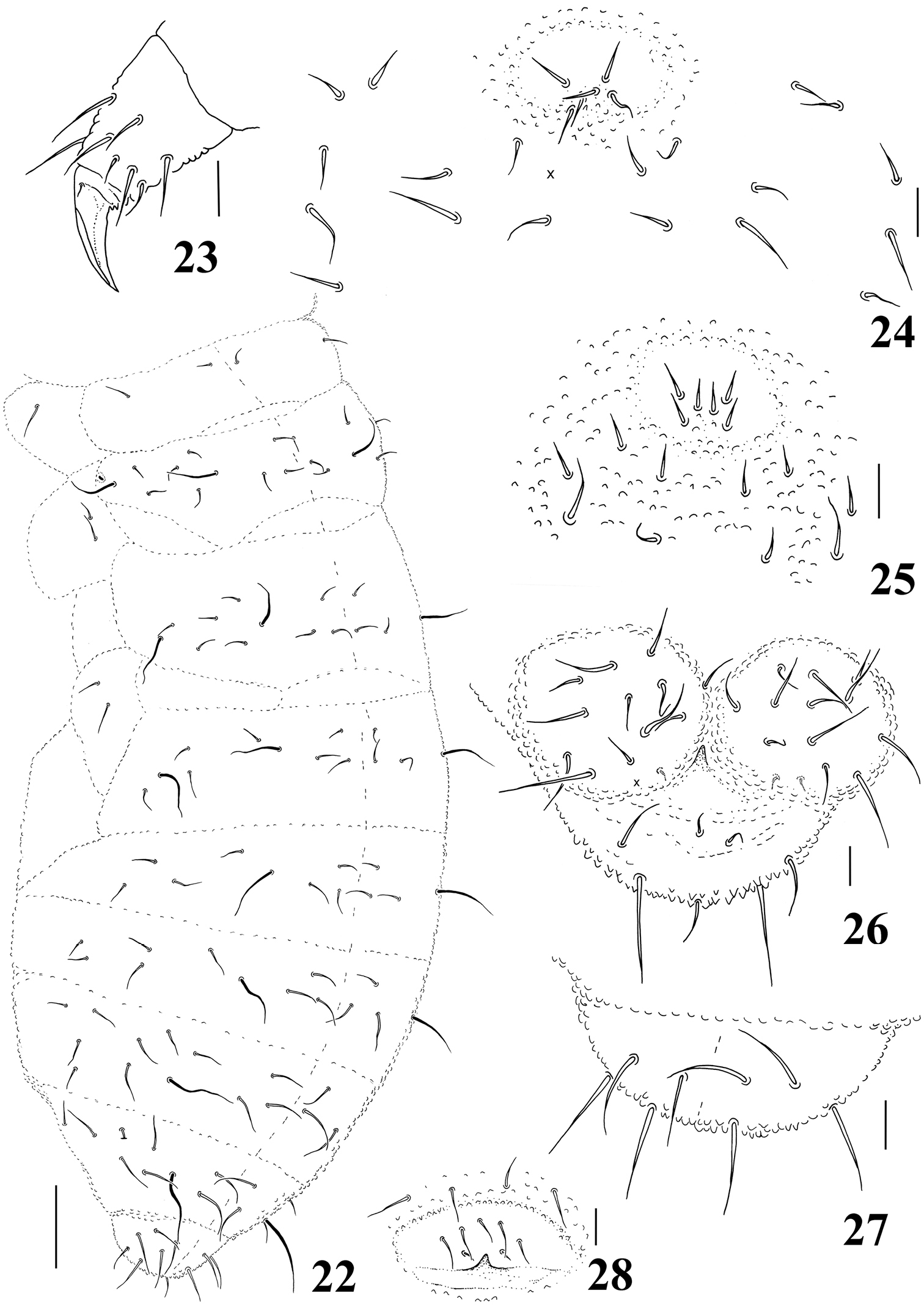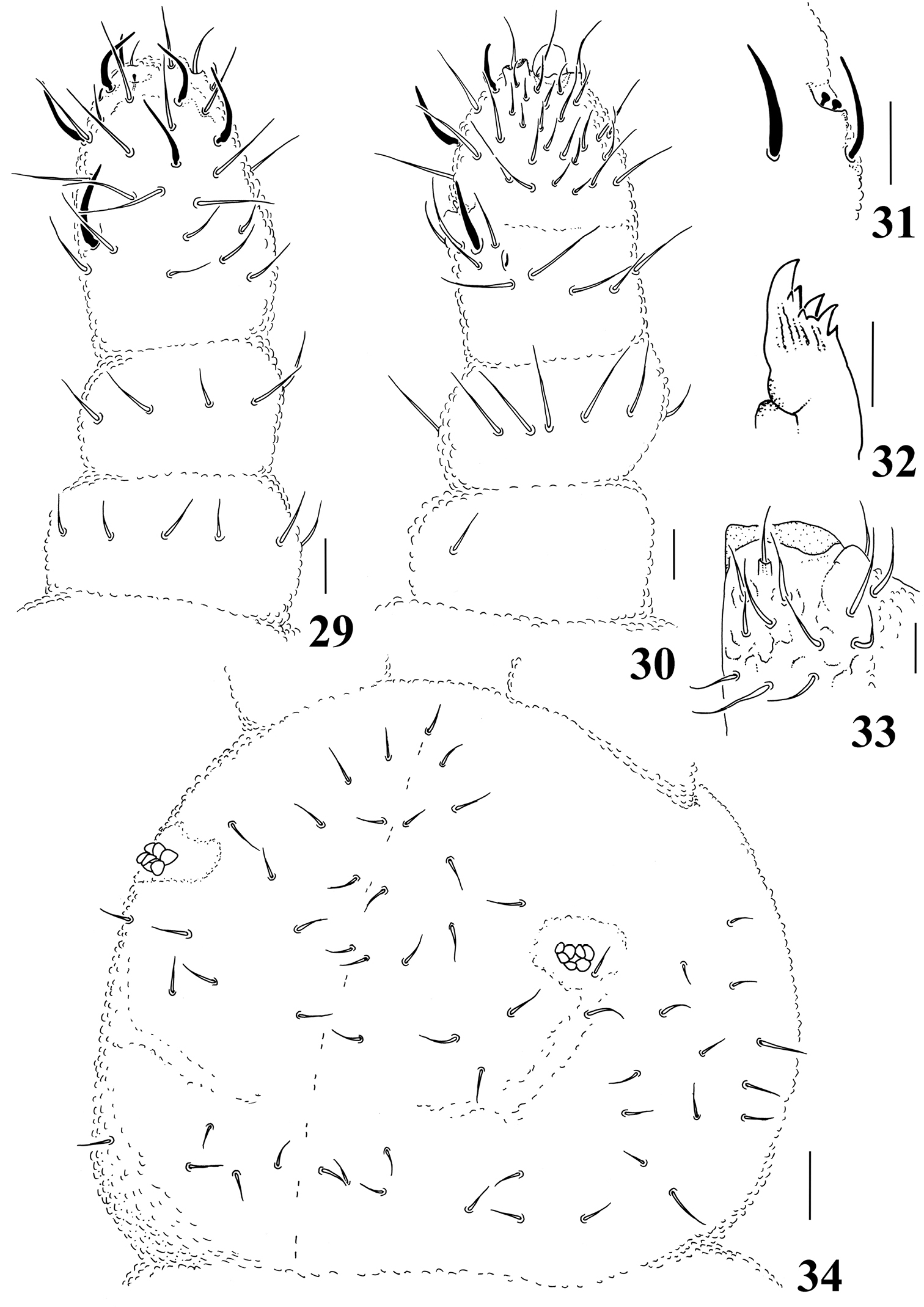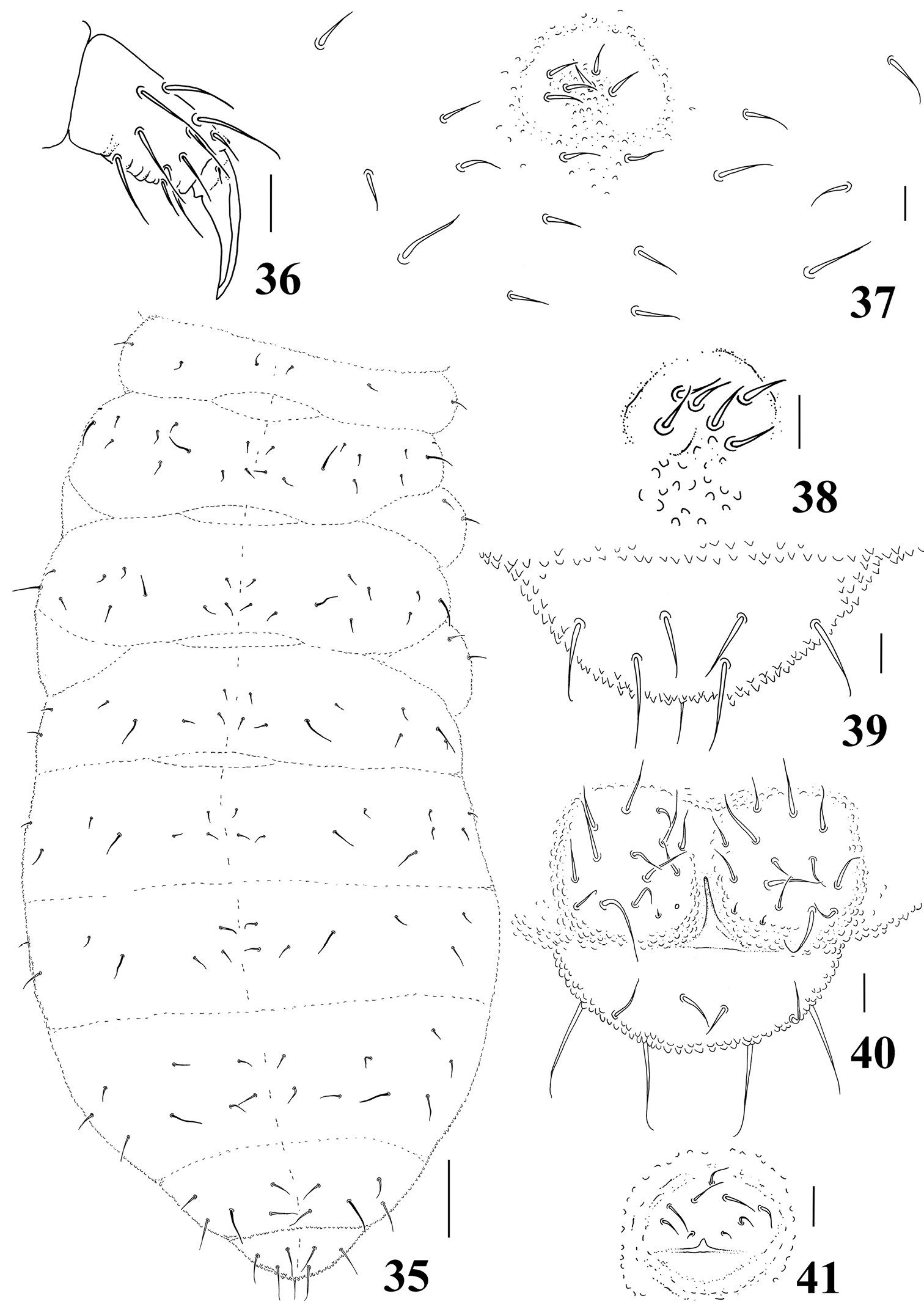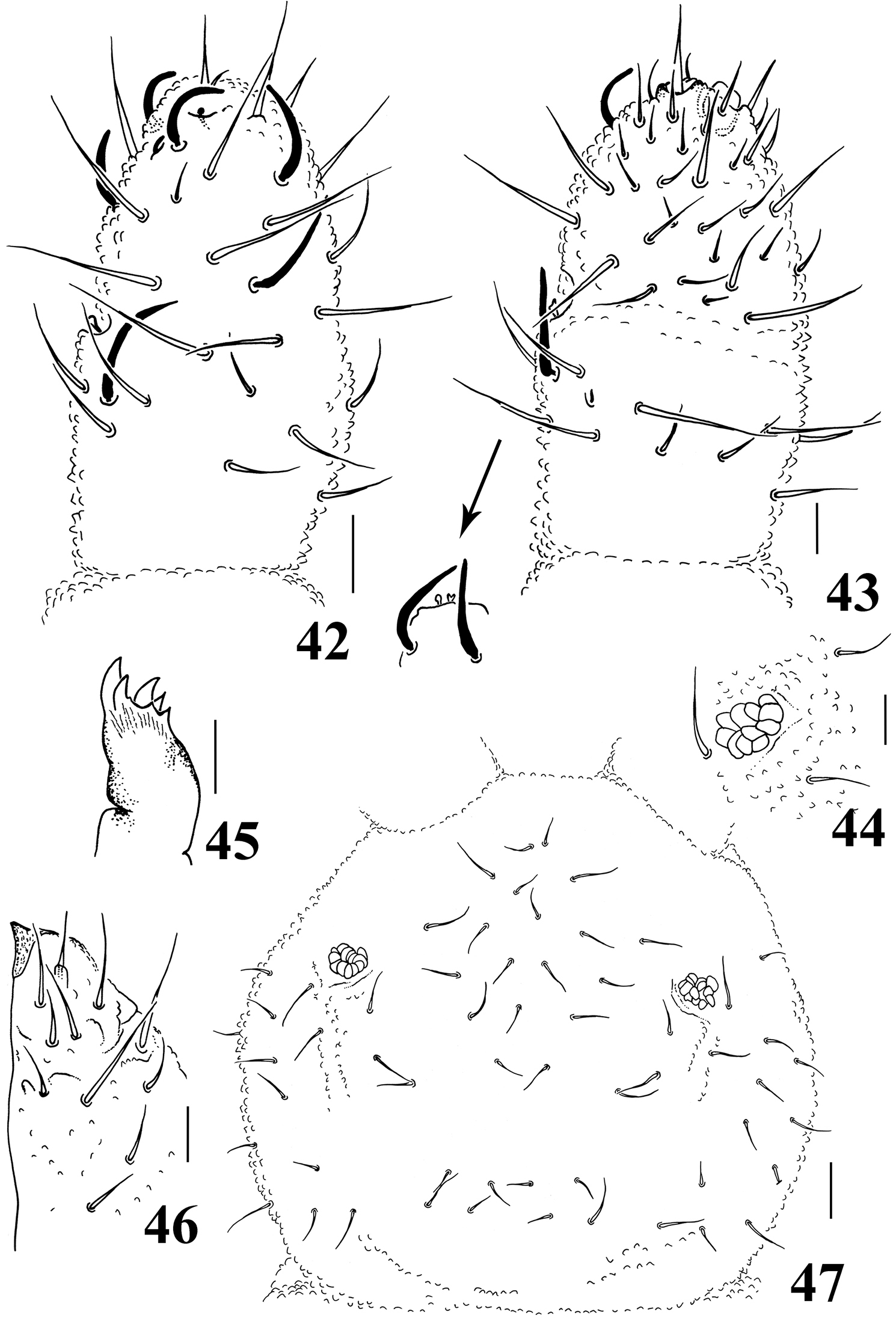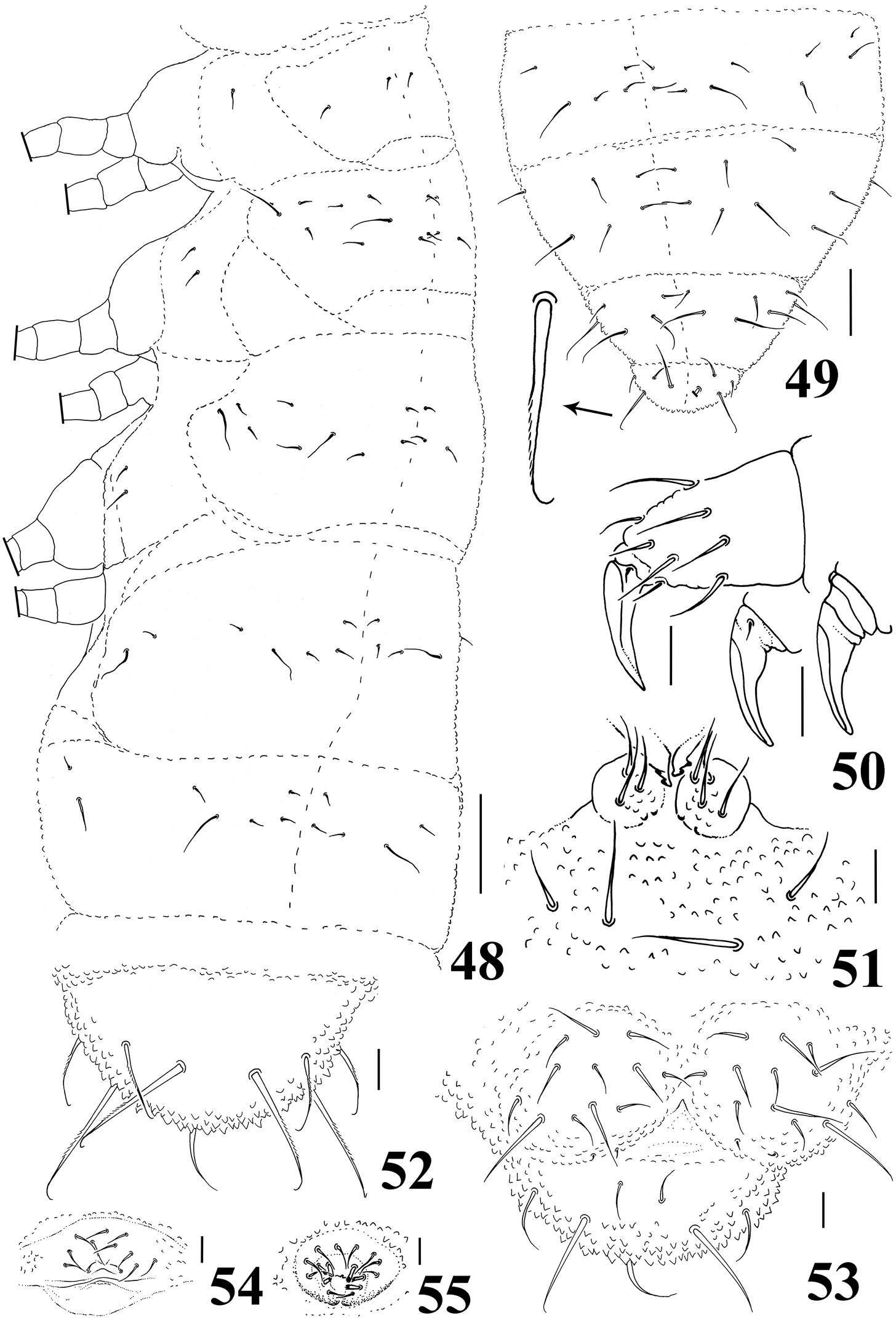






(C) 2013 Gabriel C. Queiroz. This is an open access article distributed under the terms of the Creative Commons Attribution License 3.0 (CC-BY), which permits unrestricted use, distribution, and reproduction in any medium, provided the original author and source are credited.
For reference, use of the paginated PDF or printed version of this article is recommended.
Citation: Queiroz GC, de Mendonça MC (2013) New species of Brachystomellidae and characterization of Micronella porcus (Denis, 1933) from Brazil. ZooKeys 316: 81–98. doi: 10.3897/zookeys.316.4869
Three new species of Brachystomellidae from high altitude fields of southeast Brazil are described and illustrated and additions made to the description of Micronella porcus (Denis, 1933). The new species are Neorganella rotundatae sp. n., the second for the genus, Micronella itacaman sp. n. and Micronella longisensilla sp. n. Diagnosis of the genera have been extended. An identification key to the genus Micronella Arlé, 1959 is provided.
Taxonomy, chaetotaxy, biodiversity, Neorganella, Neotropic
The cosmopolitan family Brachystomellidae is, currently, comprised of 18 genera and 130 species (
The Neotropical fauna of Brachystomellidae is particularly diverse, especially for a group of euedaphic pale species that presents reductions of sense organs and appendages, such as eyes and/or furca. It is the case, for instance, of the Neotropical genera Folsomiella Bonet, 1930 (six species), Maricaella Mendonça & Fernandes, 1997 (monospecific), Micronella Arlé, 1959 (two species), Neorganella Rapoport & Rubio, 1963 (monospecific) and Winterella Massoud, 1967 (monospecific). The first three genera occurs in different habitats, such as sandy seashores and its surrounding vegetation, tropical forests and high altitude in mountains of the Andes, while Neorganella and Winterella are only found at high altitude mountains of the Andes (above 2, 000 m a.s.l.).
In Brazil, the Brachystomellidae fauna comprises 19 species in seven genera (
Recent expeditions, in order to sample the collembolan biodiversity from summits of three of the highest mountain plateaus of southeastern Brazil, always over than 2, 000 m a.s.l., have revealed three new pale Brachystomellidae species which are herein described and illustrated: Micronella itacaman sp. n., Micronella longisensilla sp. n. and Neorganella rotundatae sp. n. In addition, a new record of Micronella porcus from the State of Minas Gerais, Brazil, and, due to its succinct original description, that lacks body chaetotaxy and other characters, these specimens are characterized and illustrated.
Abd–abdominal segment; Ant–antennal segment; a.s.l.–above sea level; Cx–coxa; Fe–femur; ICMBio–Instituto Chico Mendes da Biodiversidade; MG–Minas Gerais State; MNHN–Muséum National D'Histoire Naturelle; MNRJ–Museu Nacional do Rio de Janeiro; PAO–postantennal organ; RJ–Rio de Janeiro State; Scx–subcoxa; Th–thoracic segment; Tita–tibiotarsus; Tr–trochanter.
The genus Micronella was erected by
Table of localities
| Species | Latitude, Longitude |
|---|---|
| Micronella itacaman sp. n. | 22°22'59"S, 44°40'01"W |
| 22°27'38"S, 43°01'45"W | |
| 20°26'07"S, 41°47'54"W | |
| Micronella longisensilla sp. n. | 22°27'38"S, 43°01'45"W |
| Micronella porcus (Denis, 1933) | 20°26'07"S, 41°47'54"W |
| Neorganella rotundatae sp. n. | 22°22'59"S, 44°40'01"W |
Both Micronella species were briefly described, without any mention to dorsal body and also the furcal area chaetotaxy, which contains a set of chaetae that can be of taxonomic importance. Nevertheless, the analysis of Brachystomellidae made by
Concerning Neorganella Rapoport & Rubio, 1963, the only species of the genus Neorganella nothofagutalis Rapoport & Rubio, 1963 was described based on a single specimen from a mountain called “El Roble”, of about 2, 000 m a.s.l. and 50km from the Pacific Ocean. In 1967, Massoud synonymized Neorganella with Folsomiella and this remained until recently, when
As for the first two species of Micronella, there is no reference to head and most of the dorsal body chaetotaxy, regardless of the drawing of Abd III–VI in the original description, which is not elucidative. Nevertheless, the genus is well established among the Brachystomellidae, due to the presence of a reduced furca without mucro. The analysis of
http://species-id.net/wiki/Micronella
Brachystomella porcus Denis, 1933.
Diagnosis. Pigmentation absent. Antennae shorter than head diagonal. Ant IV with dorsolateral microsensillum and round subapical organite; apical vesicle simple. Eyes absent. PAO with 6–15 vesicles. Maxilla typical of Brachystomella, with 5–7 teeth. Unguis tooth present or absent; tenent hair acuminated. Ventral tube with 3+3 chaetae. Furcal area delimited by a circular region of primary granulation of the tegument and a set of six chaetae within it. Table 1 summarizes the main characters of the species of the genus.
Main characters of species of Micronella Arlé, 1959.
| Species | checayensis Massoud, 1967 | porcus (Denis, 1933) | itacaman sp. n. | longisensilla sp. n. |
| Ant IV sensilla | ? | 6 | 5 | 4 |
| Shape of sensilla of Ant III organ | curved, opposite sense | “club” | one bilobed, one “club” | “cloverleaf” |
| PAO vesicles | 15 | 6–8 | 7–8 | 12–13 |
| Ratio ordinary chaetae: sensilla | ? | 1:1.3 | 1:1 | 1:2 |
| Serrated chaetae on body | ? | – | + | – |
| Unguis tooth | + | – | + |
– |
| Type Locality | Peru | Costa Rica | Brazil (southeast) | Brazil (RJ) |
†Seen only on unguis of Tita I and II.
| 1 | PAO with up to 13 vesicles; unguis without or with minute inner tooth | 2 |
| – | PAO with 15 vesicles, unguis with inner tooth | Micronella checayensis Massoud, 1967 |
| 2 | PAO with up to 8 vesicles; ratio chaetae: sensilla approximatelly 1:1 | 3 |
| – | PAO with 12–13 vesicles; ratio chaetae: sensilla = 1:2 | Micronella longisensilla sp. n. |
| 3 | Ant IV with six sensilla; smooth chaetae on body; unguis without inner tooth | Micronella porcus (Denis, 1933) |
| – | Ant IV with five sensilla; serrated chaetae on body; unguis of Tita I and II with minute inner tooth | Micronella itacaman sp. n. |
urn:lsid:zoobank.org:act:E02CF5EA-2148-496C-BC05-253533ABFACB
http://species-id.net/wiki/Micronella_itacaman
Figs 1–14Holotype: female, on slide. Label: Nº 2332 CM/MNRJ, Itatiaia, RJ, Brasil, Queiroz, G.C. leg, 27.iii.2012, 22°22'59"S, 44°40'1"W. Paratype: 1 female on slide, Label: Nº 2138 CM/MNRJ (D), Itatiaia, RJ, Brasil; Queiroz, G.C. leg, 14.vii.2011, 22°22'59"S, 44°40'1"W. Deposited at MNRJ, Rio de Janeiro, Brazil.
Brasil, Rio de Janeiro: Itatiaia municipality, Parque Nacional de Itatiaia (ICMBio), 22°22'59"S, 44°40'1"W, leaf litter and soil of “campos de altitude”, 2, 400 m a.s.l.
Other material. One female on slide, Label: Nº 2153 CM/MNRJ (A), Alto Caparaó, MG, Brasil, Queiroz, G.C. leg, 27.vii.2011, 20°26'7"S, 41°47'54"W. Deposited at MNRJ, Rio de Janeiro, Brazil. One specimen deposited at MNHN, Paris, France: female, on slide, MNHN-EA011504, Teresópolis, RJ. Brasil, Queiroz, G.C. leg; 30.iii.2011, 22°27'38"S, 43°1'45"W.
Habitus typical of the genus. Body length of holotype: 0.88 mm; body length range of paratypes: 0.63–0.90 mm. Color in ethanol: white, no pigmentation.
Ratio head diagonal: antenna = 1:0.63. Ant I with 7 chaetae. Ant II with 12 chaetae. Ant III and IV fused dorsally, ventral separation marked. Sensory organ of Ant III with two small club shaped sensilla, the mid-ventral one with a bilobed apex; two longer and subcylindrical guard sensilla; ventral microsensillum present (Figs 1–2). All dorsal chaetae of Ant I–III are serrated, ventral chaetae smooth and longer than those from dorsal side (10–13 μm dorsal; 13–15 μm ventral). Ant IV with simple apical bulb and five sensilla, three weakly differentiated from ordinary chaetae; dorsolateral microsensillum present; subapical organite round; with about 30 ventral chaetae (Fig. 2).
Micronella itacaman sp. n. 1 Dorsal view of Ant I–IV 2. Ventral view of Ant I–IV 3 PAO and its surrounding chaetae 4 Maxilla 5 Labium 6 Head chaetotaxy of specimen from Itatiaia 7 Head chaetotaxy of specimen from Teresópolis 8 Head chaetotaxy of specimen from Alto Caparaó. Scale bars: 10μm (1–5); 20 μm (6–8).
Without eyes. PAO bearing 7–8 vesicles disposed as a rosette (Fig. 3). Maxilla quadrangular with 6–7 teeth (Fig. 4). Labral formula: 2/2334. Labium typical of Brachystomella, with one papillated chaeta (L) and four proximal chaetae (Fig. 5).
Head chaetotaxy as in Figs 6–8; asymmetries in the number of axial chaetae. Chaetae a0 present; Oc chaetae 3+3. Dorsal chaetotaxy composed of ordinary serrated chaetae and sensilla subequal in size, becoming longer towards the distal segments of the body (15 µm in Th I and 25 µm in Abd VI) (Fig. 9). Ratio of body ordinary chaetae: sensilla = 1:1. Th I with 2+2 chaetae; sensillar formula by half tergum: 022/211110.
Micronella itacaman sp. n. 9. Dorsal body chaetotaxy with details of sensilla and chaetae 10 Tita of leg I 11 Furcal area 12 Dorsal view of Abd VI 13 Anal valves and ventral view of Abd VI 14 Female genital plate. Scale bars: 10μm (10–14); 50μm (9).
Chaetotaxy of legs I–III as follows: Scx I– 1, 2, 2; Scx II– 0, 2, 2; Cx– 3, 6, 7; Tr– 5, 5, 5; Fe– 12, 10, 10; Tita– 19, 19, 18. All chaetae of Scx I of legs I–III are serrated. Tenent hair on tibiotarsi acuminate; unguis of legs I and II with one extremely minute median inner tooth; tooth not seen on unguis of leg III (Fig. 10). Ventral tube with 3+3 chaetae. Without tenaculum. Furca completely absent, but with a well-defined furcal area with six chaetae arranged in two rows: anterior row with four chaetae and posterior row with two chaetae (Fig. 11). Abd VI with 4+4 serrated chaetae and one unpaired smooth chaetae on dorsal side (Fig. 12). Each anal valve with 12–13 chaetae and 2 hr chaetae; Abd VI with 3+3 smooth chaetae on ventral side (Fig. 13). Female genital plate as in Fig. 14.
“Itakamã” (pronounced itakaman) means “high stone” or “rocky mountain” in the indigenous language Tupi, spoken by the Brazilian natives, reference to the three highest mountain plateaus of southeast Brazil, where the species was found.
The new species, Micronella itacaman sp. n., is well characterized in the genus, as all the species share euedaphic characters such as absence of eyes and furca, but with PAO. It can be distinguished from its congeners by characters such as serrated chaetae on body and five sensilla on Ant IV. In relation to number of vesicles on PAO and ratio of ordinary chaetae: sensilla, the new species is most similar to Micronella porcus, as they have 6–8 vesicles and a ratio of ordinary chaetae: sensilla of approximately 1:1.
urn:lsid:zoobank.org:act:B4515695-AD7E-4436-A3BF-FF131F3C9F76
http://species-id.net/wiki/Micronella_longisensilla
Figs 15–28Holotype: female, on slide. Label: Nº 2207 CM/MNRJ (B), Teresópolis, RJ. Brasil, Queiroz, G.C. leg; 09.xi.2011, 22°27'38"S, 43°1'45"W. Paratypes: 4 females on slides and 1 specimen in ethanol, 2207 CM/MNRJ (A and C), same data as holotype. Deposited at MNRJ, Rio de Janeiro, Brazil.
One female on slide. Label: Nº 2020 CM/MNRJ, Teresópolis, RJ. Brasil, Queiroz, G.C. leg; 30.iii.2011, 22°27'38"S, 43°1'45"W; 1 specimen in ethanol, 2023 CM/MNRJ, Teresópolis, RJ. Brasil, Queiroz, G.C. leg; 30.iii.2011, 22°27'38"S, 43°1'45"W; 2 females on slide, Nº 2092 CM/MNRJ (C), Teresópolis, RJ. Brasil, Queiroz, G.C. leg; 29.vi.2011, 22°27'38"S, 43°1'45"W; 1 female on slide and 3 specimens in ethanol, Nº 2211 CM/MNRJ (A), Teresópolis, RJ. Brasil, Queiroz, G.C. leg; 10.xi.2011, 22°27'38"S, 43°1'45"W; 1 female on slide, Label: Nº 2212 CM/MNRJ (D), Teresópolis, RJ. Brasil, Queiroz, G.C. leg; 10.xi.2012, 22°27'38"S, 43°1'45"W; 1 female on slide, Label: Nº 2302 CM/MNRJ (A), Teresópolis, RJ. Brasil, Queiroz, G.C. leg; 14.iii.2012, 22°27'38"S, 43°1'45"W; 1 specimen in ethanol, Nº 2307 CM/MNRJ, Teresópolis, RJ. Brasil, Queiroz, G.C. leg; 14.iii.2012, 22°27'38"S, 43°1'45"W; 1 specimen in ethanol, Nº 2314 CM/MNRJ, Teresópolis, RJ. Brasil, Queiroz, G.C. leg; 15.iii.2012, 22°27'38"S, 43°1'45"W; 1 specimen in ethanol, Nº 2317 CM/MNRJ, Teresópolis, RJ. Brasil, Queiroz, G.C. leg; 15.iii.2012, 22°27'38"S, 43°1'45"W. Deposited at MNRJ, Rio de Janeiro, Brazil. Two specimens deposited at MNHN, Paris, France: 1 female on slide, MNHN-EA011506, Teresópolis, RJ. Brasil, Queiroz, G.C. leg; 10.xi.2011, 22°27'38"S, 43°1'45"W; 1 female on slide, MNHN-EA011505, Teresópolis, RJ. Brasil, Queiroz, G.C. leg; 14.iii.2012, 22°27'38"S, 43°1'45"W.
Brasil, Rio de Janeiro, Teresópolis municipality, Parque Nacional da Serra dos Órgãos (ICMBio), 22°27'38"S, 43°1'45"W, leaf litter and soil of “campos de altitude”, 2, 100 m a.s.l.
Habitus typical of the genus. Body length of holotype: 0.62 mm; body length range of paratypes: 0.40–0.75 mm. Color in ethanol: white, no pigmentation.
Ratio head diagonal: antenna = 1:0, .66. Ant I with 7 chaetae. Ant II with 11 chaetae. Ant III and IV fused dorsally, ventral separation marked. Sensory organ of Ant III with two cloverleaf-shaped sensilla partially covered by a fold of the integument; two longer and subcylindrical guard sensilla, the dorsal one is shorter but greatly enlarged in its width, in relation to the ventral one; ventral microsensillum present (Figs 15–18). Ant IV with simple apical bulb and four sensilla; dorsolateral microsensillum present; subapical organite round; with about 30 ventral chaetae (Fig. 16).
Micronella longisensilla sp. n. 15 Dorsal view of Ant III–IV 16 Ventral view of Ant III–IV 17 Detail of Ant III organ 18 Detail of Ant III organ (same specimen of Fig. 17, right antennae) 19 Maxilla 20 Labium 21 Head. Scale bars: 10μm (15–20); 20μm (21). x represents missing chaeta.
Without eyes. PAO bearing 12–13 vesicles disposed as a rosette. Maxillae quadrangular with 6–7 teeth (Fig. 19). Labral formula: 2/2334. Labium typical of Brachystomella, with one papillated chaeta (L) and four proximal chaetae (Fig. 20).
Head chaetotaxy as in Fig. 21. Chaetae a0 present; Oc chaetae 3+3, sometimes asymmetric of 2+3. Dorsal chaetotaxy composed of smooth ordinary chaetae (10–25μm) and long sensilla (25–50μm), that becomes longer towards distal segments of the body. Ratio body ordinary chaetae: sensilla = 1:2. Th I with 2+2 chaetae; sensillar formula by half tergum: 022/211110 (Fig. 22).
Chaetotaxy of legs I–III as follows: Scx I– 1, 2, 2; Scx II– 0, 2, 2; Cx– 3, 6, 7; Tr– 5, 5, 4; Fe– 12, 11, 10; Tita– 19, 19, 18. Tenent hair on tibiotarsi acuminate; unguis without tooth (Fig. 23). Ventral tube with 3+3 chaetae. Without tenaculum. Furca completely absent, but with a well-defined furcal area with six chaetae (Figs 24–25).Each anal valve with 11–12 chaetae and 2 hr chaetae; Abd VI with 3+3 chaetae on ventral side, 4+4 chaetae on dorsal side and one unpaired chaetae (Figs 26–27). Female genital plate as in Fig. 28.
Micronella longisensilla sp. n. 22 Dorsolateral body chaetotaxy 23 Tita of leg I 24 Furcal area and its surrounding chaetae (adult) 25 Furcal area and its surrounding chaetae (juvenile) 26 Anal valves and ventral view of Abd VI 27 Dorsal view of Abd VI 28 Female genital plate. Scale bars: 10μm (23–28); 50μm (22). x represents missing chaeta.
In a reference to the size of the sensilla in relation to ordinary chaetae on body of the new species.
The new species, Micronella longisensilla sp. n., is well characterized in the genus (see Table 1). It differs from its congeners in relation to the ratio of ordinary chaetae: sensilla, that is 1:2, only four sensilla on Ant IV, a PAO with 12–13 vesicles, the Ant III organ with two cloverleaf-shaped sensilla under a fold of the tegument and the dorsal guard sensilla which is greatly enlarged in its width, in relation to the ventral one.
One female on slide, Label: Nº 2037 CM/MNRJ (C), Alto Caparaó, MG, Brasil, Queiroz, G.C. leg, 12.iv.2011, 20°26'7"S, 41°47'54"W; 1 female on slide and 2 specimens in ethanol, Nº 2041 CM/MNRJ (D), Alto Caparaó, MG, Brasil, Queiroz, G.C. leg, 13.iv.2011, 20°26'7"S, 41°47'54"W; 1 female and 1 juvenile on slides, Label: Nº 2353 CM/MNRJ (C and E), Alto Caparaó, MG, Brasil, Queiroz, G.C. leg, 11.iv.2012, 20°26'7"S, 41°47'54"W; 1 young female and 1 juvenile on slides, Label: Nº 2354 CM/MNRJ (A and B), Alto Caparaó, MG, Brasil, Queiroz, G.C. leg, 11.iv.2012, 20°26'7"S, 41°47'54"W. Deposited at MNRJ, Rio de Janeiro, Brazil. Two specimens deposited at MNHN, Paris, France: 1 female on slide MNHN-EA011501; 1 female on slide, Label: MNHN-EA011500, Alto Caparaó, MG, Brasil, Queiroz, G.C. leg, 13.iv.2011, 20°26'7"S, 41°47'54"W.
Brasil, Minas Gerais: Alto Caparaó municipality, Parque Nacional do Caparaó (ICMBio), 20°26'7"S, 41°47'54"W, leaf litter and soil of “campos de altitude”, 2, 700 m a.s.l.
Habitus typical of the genus. Body length range of specimens: 0.45–0.95 mm. Color in ethanol: white, no pigmentation.
Ratio head diagonal: antenna = 1:0.57. Ant I with 7 chaetae. Ant II with 12 chaetae. Ant III and IV fused dorsally, ventral separation marked. Sensory organ of Ant III with two club-shaped sensilla; two longer and subcylindrical guard sensilla, the dorsal is stouter than ventral guard sensilla; ventral microsensillum present (Figs 29–31). Ant IV with simple apical bulb and six slender sensilla; dorsolateral microsensillum present; subapical organite round; with about 30 ventral chaetae (Fig. 30).
Without eyes. PAO bearing 7–8 vesicles disposed as a rosette. Maxilla quadrangular with 6–7 teeth (Fig. 32). Labral formula: 2/2334. Labium typical of Brachystomella, with one papillated chaeta (L) and four proximal chaetae (Fig. 33).
Micronella porcus (Denis, 1933). 29. Dorsal view of Ant I–IV 30 Ventral view of Ant I–IV 31 Detail of Ant III organ 32 Maxilla 33 Labium 34 Head chaetotaxy. Scale bars: 10μm (29–33); 20μm (34).
Head chaetotaxy as in Fig. 34. Chaetae a0 present, but some specimens with asymmetries; Oc chaetae 3+3. Dorsal chaetotaxy composed of smooth ordinary chaetae (15–20 µm) and longer sensilla (20–25 µm) that becomes longer towards distal segments of the body. Ratio ordinary chaetae: sensilla = 1:1.3. Th I with 2+2 chaetae; sensillar formula by half tergum: 022/211110 (Fig. 35).
Micronella porcus (Denis, 1933). 35 Dorsal body chaetotaxy 36 Tita of leg I 37 Furcal area and its surrounding chaetae 38 Detail of furcal area 39 Dorsal view of Abd VI 40 Anal valves and ventral view of Abd VI 41 Female genital plate. Scale bars: 10μm (36–41); 50μm (35).
Chaetotaxy of legs I–III as follows: Scx I– 1, 2, 2; Scx II– 0, 2, 2; Cx– 3, 6, 7; Tr– 5, 5, 4; Fe– 12, 11, 10; Tita– 19, 19, 18. Tenent hair on tibiotarsi acuminated; unguis without tooth (Fig. 36). Ventral tube with 3+3 chaetae. Without tenaculum. Furca completely absent, but with a well-defined furcal area with six chaetae (Figs 37–38). Abd VI with 4+4 chaetae on dorsal side and one unpaired chaetae; with 3+3 chaetae on the ventral side (Fig. 39). Each anal valve with 12–13 chaetae and 2 hr chaetae; (Fig. 40). Female genital plate as in Fig. 41.
The examined specimens from Minas Gerais State, Brazil, fit the description of the Neotropical species Micronella porcus. The six sensilla on Ant IV, the club-shaped sensilla on Ant III organ, the 6–8 vesicles on PAO and the toothless unguis are the main characters that define the species. The description above adds important characters such as head and dorsal body chaetotaxy and also the number of chaetae on furcal area to the original description.
Pigmentation absent, pale aspect. Antennae shorter than head diagonal. Ant IV with dorsolateral microsensillum and round subapical organite; apical vesicle simple. Eyes absent. PAO with 4–12 vesicles. Maxilla typical of Brachystomella, with 5–7 teeth. Unguis tooth present or absent; tenent hair acuminate. Ventral tube with 3+3 chaetae. Tenaculum present. Reduced furca: without mucro, but with two small rounded or globular dens, each with 3–4 chaetae.
urn:lsid:zoobank.org:act:0AA68A6D-A503-4695-89E2-64893DEE33B3
http://species-id.net/wiki/Neorganella_rotundatae
Figs 42–55Holotype: male, on slide, Label: Nº 1984 CM/MNRJ, Itatiaia, RJ, Brasil, Queiroz, G.C. leg, 14.iii.2011, 22°22'59"S, 44°40'1"W. Paratypes: 1 female and 4 juveniles on slides, Label: Nº 2133 CM/MNRJ (C and D), Itatiaia, RJ, Brasil, Queiroz, G.C. leg, 13.vii.2011, 22°22'59"S, 44°40'1"W. Deposited at MNRJ, Rio de Janeiro, Brazil. Two specimens deposited at MNHN, Paris, France: 1 female on slide, MNHN-EA011502, Itatiaia, RJ, Brasil, Queiroz, G.C. leg, 13.vii.2011, 22°22'59"S, 44°40'1"W1 juvenile on slide, MNHN-EA011503, Itatiaia, RJ, Brasil, Queiroz, G.C. leg, 25.x.2011, 22°22'59"S, 44°40'1"W.
Brasil, Rio de Janeiro: Itatiaia municipality, Parque Nacional de Itatiaia (ICMBio), 22°22'59"S, 44°40'1"W, leaf litter and soil of “campos de altitude”, 2, 400 m a.s.l.
Habitus typical of the family. Body length of holotype: 0.88 mm; body length range of paratypes: 0.47–1.20 mm. Color in ethanol: white, no pigmentation.
Ratio head diagonal: antenna = 1:0.63. Ant I with 7–8 chaetae. Ant II with 12 chaetae. Ant III and IV fused dorsally, ventral separation marked. Sensory organ of Ant III with two small club-shaped sensilla, the mid-ventral one with a bilobed apex; two longer and subcylindrical guard sensilla; ventral microsensillum present (Figs 42–43). Ant IV with simple apical bulb and five sensilla; dorsolateral microsensillum present; subapical organite round; about 30 ventral chaetae (Figs 42–43).
Neorganella rotundatae sp. n. 42 Dorsal view of Ant II–IV 43 Ventral view of Ant III–IV with detail of Ant III organ 44 Detail of PAO 45 Maxilla 46 Labium 47 Head chaetotaxy. Scale bars: 10μm (42–46); 20μm (47).
Without eyes. PAO bearing 10–12 vesicles disposed as an elongated rosette (Fig. 44). Maxilla quadrangular with 6–7 teeth (Fig. 45). Labral formula: 2/2334. Labium typical of Brachystomella, with one papillated chaetae (L) and four proximal chaetae (Fig. 46).
Head chaetotaxy as in Fig. 47. Chaetae a0 absent; Oc chaetae 3+3. Dorsal chaetotaxy composed of slightly serrated chaetae and longer sensilla (Fig. 48); Abd V with some longer chaetae, subequal to sensilla, and Abd VI with 4+4 serrated chaetae with a tendency to have bent tips (Fig. 49). Th I with 2+2 chaetae; sensillar formula by half tergum: 022/211110. All dorsal and lateral chaetae are slightly serrated.
Neorganella rotundatae sp. n. 48 Dorsolateral chaetotaxy of Th I–Abd II 49 Dorsolateral chaetotaxy of Abd III–VI with detail of chaetae 50 Tita of leg II with detail of two unguis (left: unguis III; right: unguis II) 51 Tenaculum and reduced furca 52 Dorsal view of Abd VI 53 Anal valves and ventral view of Abd VI 54 Female genital plate 55 Male genital plate. Scale bars: 10μm (50–55); 50μm (48–49).
Chaetotaxy of legs I–III as follows: Scx I – 1, 2, 2; Scx II – 0, 2, 2; Cx – 3, 6, 7; Tr – 5, 5, 5; Fe – 12, 12?, 10; Tita – 18, 18, 17. Tenent hair on tibiotarsi acuminated; unguis of legs I and II with one extremely minute median inner tooth; tooth not seen on unguis of leg III (Fig. 50). Ventral tube with 3+3 chaetae. Tenaculum small with 2 teeth on each ramus. Furca reduced to two small globular dens with 3–4 chaetae on each side and without mucro (Fig. 51). Abd VI with 4+4 serrated chaetae with bent tips, of which 2+2 are longer than others (25μm to 20μm), and one unpaired smooth chaetae on dorsal side (Fig. 52). Each anal valve with 12 chaetae and 2 hr chaetae; Abd VI with 3+3 smooth chaetae on ventral side (Fig. 53). Female and male genital plate as in Figs 54 and 55, respectively.
The Latin word rotundatae means roundish, spherical, referring to dens shape of the new species.
The new species Neorganella rotundatae sp. n. is well characterized in the genus, mainly due to the facts that it shares a reduced furca without mucro, dens with 3+3 chaetae, and the presence of tenaculum with the other species Neorganella nothofagutalis Rapoport & Rubio, 1963 (according to original description and after
The financial support of CAPES (PDSE scholarship #18865-12-7). The ICMBio staff of National Parks of Itatiaia, Serra dos Órgãos and Caparaó for logistical support. The valuable comments of two reviewers on previous drafts that greatly improved the article.
